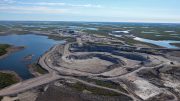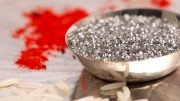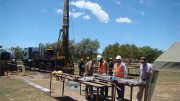Since Canada’s second diamond mine, Diavik, went into production in 2003, its 40% owner — at that time known as Aber Diamond — has been looking for other quality diamond assets to buy.
Initially, it was hoping to repeat the success it had with partner Rio Tinto (RIO-N, RIO-L) in finding Diavik, located 300 km northeast of Yellowknife in the Northwest Territories, by acquiring another exploration project.
In those days, however, diamonds were hot, with both major conglomerates and well-financed juniors pouring money into diamond exploration. So says Robert Gannicott, the chairman and CEO of the company — recently renamed Dominion Diamond (DDC-T, DDC-N).
“It was an extremely competitive space, and because I think we understood how the diamond exploration space works we said, no that’s not a very good place to be — everything out there is expensive and very high risk,” Gannicott said in an interview from Yellowknife in mid-April.
So, looking for insight on how to get the best price for its portion of Diavik’s production, the company decided to go into the retail arena instead, with the purchase of the luxury jewelry brand Harry Winston Diamond.
It paid US$266 million for Harry Winston in two transactions in 2004 and 2006, took the name of the iconic brand, and invested another US$36 million in the retail business.
While the retail division struggled during the financial crisis, the business took off in a dramatic way in 2010, with luxury brand sales increasing by 89%. In the year ended Jan. 31, 2011, the retail side swung to an operating profit of $14.3 million compared to a loss of $15.7 million the year before.
And then, in November 2011, came the game-changing opportunity that Dominion had been waiting for: BHP Billiton (BHP-N, BLT-L) declared it was looking to sell its 80% stake in Canada’s first diamond mine, Ekati, only about 100 km away from Diavik. Rio Tinto, Dominion’s 60% partner at Diavik, followed in March 2012 with news that it, too, was rethinking its involvement in diamonds.
“All of a sudden, the opportunity came around on the mining side, an opportunity that had not been there since the Diavik exploration started in 1991,” says Gannicott, who has been an executive with the company since its Aber days. “So we felt that it was a sensible thing to realize the value that we had created in the (Harry Winston) brand and instead turn to these mining assets.”
With that, Dominion announced the purchase of BHP’s interest in Ekati for US$500 million last November. (It ultimately paid US$553 million including price adjustments of US$53 million.) In January, it struck a deal to sell its retail division to Swatch Group for US$750 million plus the assumption of US$250 million in related debt — nearly triple what it paid for the brand.
The transformation sees Dominion becoming a mine operator for the first time. It also brings Canada’s first diamond mine coming completely under Canadian ownership (the mine’s finders, Chuck Fipke and Stu Blusson still own 10% each).
“The Northwest Territories is a place that we know and understand,” Gannicott says. “I have a background up here, other people that work with me do too, so we see really our favoured opportunities going forward as being here in the north.”
Driving that point home is Dominion’s adoption of a new logo — a maple leaf.
Ekati
The Ekati purchase included BHP’s diamond sorting and sales facilities in Yellowknife and Antwerp; an 80% interest in the Core zone at Ekati (which includes the current operation); and a 58.8% interest in the surrounding “Buffer zone” at the property, which hosts kimberlites that have exploration and development potential. The price attached to Ekati is US$400 million, while the Buffer zone is worth US$100 million. The company paid another US$53 million in purchase price adjustments.
Gannicott says there wasn’t much competition to buy the mine.
“We’re now at a stage where the junior side of the mining business finds it very difficult to raise large amounts of capital to compete in these sort of things and the other major companies don’t want to be involved in a commodity that’s as specialized and as modest in scale as the diamond business is,” he says. “So that seemed to us like a very compelling opportunity.”
There was an initial challenge by 10% owner Fipke, who had a right of first refusal on BHP’s stake. However, he dropped his legal action in February, and the sale was officially completed on April 10.
It’s difficult to evaluate the purchase because BHP never provided many details about Ekati, diamonds being such a tiny part of its overall business. But at presstime, Dominion was planning to release a new mine plan and diamond pricing information by April 24.
Given the paucity of new discoveries and the smaller size of the diamond projects that are slated to come onstream in next few years, BMO Capital Markets mining analyst Ed Sterck says choosing mining over retail was probably a wise decision for Dominion.
“My outlook for diamonds really is that supply is going to be more and more limited relative to demand,” Sterck says. “In that sort of environment, I think the retailers will have to become more competitive in terms of the prices they pay for diamonds, and as a consequence, maybe concentrating on the production and the mining end of the spectrum makes more sense.”
In the year ended June 2012, BHP’s share of production from Ekati was 1.8 million carats, while in the nine months ended in March 2013, it was 930,000 carats. (Total production over the past several years was close to 3 million carats a year.) Production is expected to remain constrained for the next two years as lower-grade ore is mined, as per the mine plan.
The current mine life for Ekati extends to 2022, but Dominion is planning on extending that by upgrading resources to reserves and conducting further exploration.
In a research note in January, RBC Capital Markets mining analyst Des Kilalea outlined the upside potential to Ekati in the Jay kimberlite. Located in the Buffer zone, Jay is not part of the mining plan, and contains a high proportion of brown diamonds (about 70%) with about 15% being colourless. Kilalea estimates their average value at US$80 per carat at current prices, with upside of about US$120 per carat if diamond prices go higher.
Investing appeal
Last year, however, diamond prices slid, with Dominion receiving about 20% less for its rough and De Beers reporting a 12% decrease. They did rebound somewhat in the first quarter (about 8%), but Sterck forecasts an overall increase of just 3% this year.
Along with the tough market for miners, the recent lacklustre performance of diamond prices hasn’t done much to boost interest in Dominion’s unique status as the only North American-listed diamond pureplay. But Gannicott says the investing appetite for the company is “good enough,” noting that diamonds are specialized and they tend to be understood better by the investment community in Europe.
“I would say the fact that the stock is pretty liquid means clearly there is an interest for it, and I think that particularly perhaps with a certain concern about gold now, diamonds are to some extent seen as another precious commodity that can be invested in that doesn’t perform like gold,” he says.
Dominion’s biggest shareholder is European fund manager M&G Investments with 19.6% of its stock. The company has 84.9 million shares outstanding and at presstime in mid-April traded at $15.33 in a 52-week range of $11.12-$17.43.
BMO’s Sterck agrees the stock, which he rates as “market perform,” could hold some appeal for investors.
“At the moment we are seeing a bit of a pullback in the valuation multiples applied to mining stocks in general, which I don’t think will last forever,” he said in early April. “But the great thing about diamonds at the moment is I think investors are looking for ways in which to play the resurgence of U.S. consumer spending and within the commodities space. Diamonds fit quite nicely within that investment thesis.”
In addition, Gannicott says the company’s knowledge of the retail side gives it insight into the diamond market, and the ability to get the best possible price for its rough. That could be a real plus when it comes to managing the volatility in prices that has become a fact of life in the business.
“Because of knowledge from the retail side, we’ve always been prepared to withhold certain sorted diamond items when we think that the rough diamond is underperforming compared to what we know the value of the polished that’s made from that item to be,” Gannicott says. “Other producers tend not to do that.”
Dominion is aiming to keep a retail connection by forming a polishing joint venture with Swatch, which was still in discussion at presstime.
Future growth
As it seeks to get a handle on operations at Ekati, perhaps next in the company’s sights is Diavik. Dominion has a first right of refusal on Rio’s stake in the mine, and it’s no secret that Gannicott would love a chance to exercise it.
Moreover, the company, which secured credit of US$640 million in connection with the Ekati purchase, has the financial werewithal for more M&A now that it has sold the Harry Winston brand.
“(We’ve) certainly got the head room to undertake a transaction with Rio on Diavik should that be available at the right price,” said Gannicott on a conference call in April.
Last year, Diavik produced 7.2 million carats of diamonds, while this year’s crop is expected to total more than 6 million carats.
However, Rio holds other diamond assets besides its 60% of Diavik. It also owns the Argyle mine in Australia, the Murowa mine in Zimbabwe, and the advanced Bunder project in India. Sterck says if Rio does sell any of them, it would prefer to sell the division as a single entity rather than risk being caught with one orphaned diamond asset.
Gannicott, who believes Rio will conclude its review within the next 12 months, says that Dominion is “not really” interested in the major’s other assets.
While Dominion’s focus is on Canada, Gannicott says the company will consider opportunities outside Canada if “they’re in parts of the world that are relatively easy to understand” and in a jurisdiction with low political risk.
As for organic growth, the company will once again focus on the area it knows best.
“We’ve got an exploration program going on to the southwest of the Diavik property on a big piece of land right now,” he says. “We’re not going to do grassroots exploration in other geographic areas, but we’ll certainly run a full-flooded exploration program in the Northwest Territories.”





Be the first to comment on "Bob Gannicott on Dominion Diamond’s new vision"